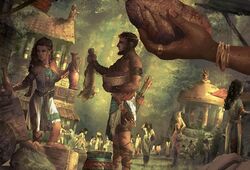Setessa
| Setessa | |
|---|---|
| Information | |
| Plane | Theros |
| Colors |
|
| Demonym | Setessan[1] |
| Part of | Mortal Realm |
| Scryfall Statistics | |
|
16 artworks | |

Setessa (/sɛtɛsə/, Seh-TEHS-ah[2]) inspired by Themiscyra, the mythical home of the Amazons as well as the DC Comics version of the location,[3] is a polis located in Theros's Nessian Forest.[4] It encompasses a sprawling area on the border between the Nistos Forest and the open chaparral. Setessa is associated with white and green mana.[5] The polis is composed primarily of women and children.[6] Setessa is the favored polis of Karametra, who nominally serves as its queen.[7]
History
Theros's first three poleis, Meletis, Akros, and Skophos, perpetuated the stark division between civilization and nature. While most humans and minotaurs embraced that division, the god Karametra tried to teach people a new way of living in harmony with nature, leading to the founding of Setessa.[7]
Geography
| “ | This city saved me when I was an orphaned child, sold into chains. Now it is my turn to save it. | ” |
—Kallias, Ophis Tower commander | ||
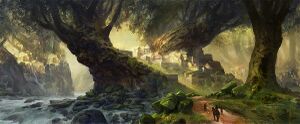
From a bird's-eye view, Setessa's layout resembles the rings of a tree, which radiate outward from the Temple of Karametra at its heart.[8]
Setessa's outermost ring is a dense circle of trees and vegetation that functions as a natural wall against outsiders.[8] The trees have platforms for archers, and the wall is constantly guarded. Karametra's warrior-priests monitor who enters and exits the city. Although the people of Setessa value community and treat each other as family, outsiders are not readily welcomed.
Locations within Setessa
- Abora Market
- a giant, open-air market just inside the main eastern gate. Every day, it is thronged with citizens buying and selling food, crafts, and curiosities. On the seven days surrounding the full moon, outsiders are allowed into the market, though they are still prohibited from roaming the rest of the polis. Visitors who try to explore beyond the market are typically banned from the polis and must forfeit any goods they bring into the city. [7]
- The caryatid groves
- sacred groves scattered across the city, devoted to Karametra and Nylea. The groves are filled with slender, tree-like figures said to resemble humans. These are caryatids — enchanted beings who offer peace to those who seek it, but who may also awaken as animated trees to defend the grove or the city if threatened.
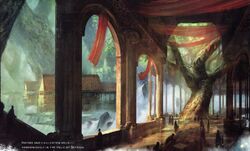
- The Four Watchtowers
- each tower is named for an animal, and each has a regiment of Setessan warriors attached to it.[7]
- Bassara Tower (fox)
- a tower near the Summer Nexus protecting the Nistos Forest, watching for interlopers who enter without Nylea's permission.[7] Bassara warriors are welcomed by Nylea and spend extended periods living among the ancient trees. During their training, they focus on archery and guerrilla warfare. Their leader is Niketa, a woman in her fifties who now spends most of her time in Setessa. She supervises archery training for the arkulli.
- Hyrax Tower (falcon)
- a wooden tower that stands on the Southern Ridge near the Autumn Nexus. It is occupied by falconers and scouts. Their leader is Phaedra, a former orphan from Meletis raised in Setessa. She is only nineteen years old, but her skills in battle earned her a place in leadership.[7]
- Leina Tower (lion) - a limestone tower that stands near the Temple to Karametra at the heart of Setessa and houses the polis's protectors. They fight with double-edged axes and provide most of the martial training for the arkulli. Their leader is Anthousa, who also leads Karametra's Council of Warriors. She is considered the god's closest advisor and de facto ruler of the city when the god is not present, which is much of the time.[7]
- Ophis Tower (serpent)
- hidden in a wild space near the temple to Karametra, it serves as a base for wandering warriors and spies who travel incognito to gather information for the Council of Warriors. They search out routes for "peregrinations," including sympathetic households who will mentor young men at the beginning of their journeys. Ophis warriors also seek lost and abandoned children and bring them back to Setessa. Their leader is Kallias, who was sold into slavery as a child. They lost an eye and several fingers before they were rescued by the Ophis and brought to Setessa.[7]
- Bassara Tower (fox)
- The Miraculous Field - a farm outside Setessa that produces incredible fruits and grains that can heal illnesses, increase fertility, and stave off hunger for days. The field is said to be Karametra's tribute to her beloved human priest, Thamuzus, who died there. While many seek the farm, it is said that the vineyard around it is so labyrinthine that few have ever reached its center.[7]
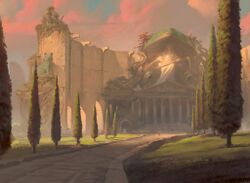
- The Temple to Karametra
- a shrine to patron of Setessa, Karametra, in the very center of the city. Three ancient trees grow from an earthen rise and spiral around the heart of the city. The temple, built of glittering limestone, nestles amid the massive trunks. Strong magical wards protect the temple since Karametra herself sits here when she visits her beloved polis. All manner of civic functions are based in the temple, and most of them are carried out by Karametra's attendants. These attendants serve as healers, advisors, teachers, chroniclers, and oracles.[7]
- The Nexuses of the Seasons
- four temples to Nylea, one for each season. Setessa has a nexus honoring each of Nylea's seasons and the accompanying Karametran planting rituals. There are no temples to gods other than these two in Setessa, but offerings to any god may be placed at these holy sites.[7] As conduits to the various gods, the nexuses are a source of enchantment magic in this region. This phenomenon is called the Kelema Veil. It has been described as a misty starfield that flows across the land. Inside the starfield are images that tell stories of the gods and can be used to predict the future.
- The Autumn Nexus
- located in a golden-apple orchard along the Southern Ridge. A natural basalt arch leads into a narrow cave where a fire is kept burning at all times. The people of Setessa believe that it is Purphoros's fire that warms the earth enough for the autumn harvest, so people give offerings in hopes of an autumn bounty. The Setessan warriors pay homage here to the Twins of War, Iroas, and Mogis, as they see honor and fear as equal parts in victory.[7]
- The Spring Nexus
- located in a lush garden behind Karametra's temple, close to the center of Setessa. A large arch of vines and flowers leads into the nexus itself and stays fresh and green all year long. The Spring Nexus is the source of the magic of abundance, summoning, and healing. Spring is the most celebratory time for Setessans - a time for planting and hope. Although they have a tumultuous relationship, Karametra speaks of Nylea as her sister and encourages people to leave offerings for her here.[7]
- The Summer Nexus
- located in an ancient olive grove west of the city proper, near the Bassara Tower. Dark green leaves form a canopy over the grove, and it is a favorite resting spot for the many animals who wander freely through the polis. Summer is seen as a time of strength, and the Summer Nexus is a source of increased power. Nylea is worshipped here, as is Iroas before the Iroan Games.[7]
- The Winter Nexus
- located at the far eastern edge of Setessa in an old lion's den believed to predate the founding of Setessa. The ancient den is in a small rocky cave below a burial mound. The cave leads down to the Underworld itself, and the smell of blood and decay hangs in the air. Setessan children occasionally dare each other to see who can make it the farthest into the cave, but the morbid atmosphere usually sends the children scurrying back before long. Here, people make offerings to Pharika and to Erebos in hopes of sparing themselves grief or pain in old age, or in remembrance of someone who now walks in the Underworld. This temple is a rumored entrance to the Underworld.[7]
- The Autumn Nexus
Locations in Setessa's surroundings
Beyond the ring of trees surrounding the city, Setessa's domain stretches across roughly a third of the Nessian Wood and a broad expanse of open chaparral. Unlike Meletis and Akros, Setessa has no villages or military outposts dotting its lands. Instead, a handful of notable sites within the forest mark the extent of Setessan influence.
Swaths of forest alternate with family dwellings and other civic structures. Setessa encompasses a sprawling area on the border between the Nistos Forest and the open chaparral. Roads are winding and narrow, and usually not wide enough to accommodate a cart. Rope bridges provide easy foot travel through the wild spaces.
- The Amatrophon
- a menagerie in the northwestern edge of Setessan territory, close to Pheres Lands. It encompasses a large forested region and provides a haven and training ground for the diverse range of animals that occupy an honored place as natural protectors in Setessan society. Experts train the renowned falcons of Setessa here, along with horses for riding and combat. More unusual animals are found here as well: trainers work with pegasi, wolves, and lions to get them ready to accompany Setessans in battle. They also wander freely through the polis, serving as free-ranging guards. Men who remain in Setessa take care of the animals and help train horses, falcons, and other animals.[7]
- The Nessian Wood
- a sprawling forest revered as Nylea's domain, its ancient trees weaving together to form a dense canopy that shields the forest floor from Heliod's blazing light. Their roots are said to reach the Rivers That Ring the World — mystical waters flowing from the Underworld itself. While the wood teems with wild and magical creatures beyond the grasp of human civilization, Nylea permits only limited hunting, and those who trespass without her blessing risk her wrath. Setessa's Bassara regiment aids the god in patrolling the forest, guarding against poachers and threats that might endanger the polis.[7] See the Nessian Wood for specific locations.
- The Southern Ridge - a high ridge along Setessa's southern border. The inhabitants of the ridge have carved it into "shelves" for terrace farming and orchards, as well as digging warren-like dwellings inside the ridge itself.[8] These defensible locations are used for protection when the city is attacked. Secret tunnels lead out into the forest.[7]
Culture
Inhabitants
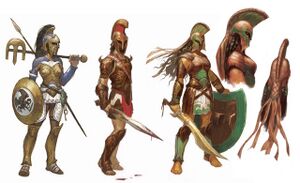
Setessa is the favored polis of Karametra, and its buildings blend so perfectly into the forest that it's difficult to tell the difference between inside and outside.[7] The populace lives in harmony with the thick forests, terraced farms, and trained animals of Setessa, and they celebrate the cycle of seasons with grand holidays. Though Setessa is a beautiful paradise, its populace is prepared to fight to the death to protect it.[7] The constant training in archery, falconry, riding, and close combat can seem out of place among the idyllic forests and beautiful gardens, and orchards, but that is the way of life in Setessa.
Civic responsibility and full protection are afforded only to citizens.[7] Citizenship is limited to those whose parents were both citizens of Setessa. Citizens of other poleis, and their children, aren't permitted to participate in the government of the polis.
Gender
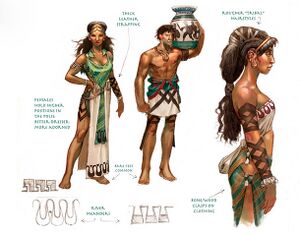
Setessa is unique among the poleis of Theros in that few of its adult residents are men.[7] There is no marriage, the property is held communally, and ancestors are traced matrilineally. Women comprise the bulk of the population, holding almost all of the leadership and military roles and carrying out most work. Most Setessan warriors begin their training as hunters, making them skilled in traversing the woods and adept at both guerrilla tactics and archery. Their strategies often emulate the favored servants of Nylea-especially wild beasts like wolves and lynxes. Typically, a few soldiers harry an enemy while the rest capitalize on their foe's distraction.
For the inhabitants of Setessa, the welfare of children is paramount.[7] Karametra, the polis's patron, is the god of orphans, and abandoned children are brought from all over Theros to be raised by the polis as a whole and treated with the highest respect. The children of Setessa are called arkulli ("little bears;" singular arkullos), and their training is a significant part of every warrior's occupation. In contrast to the discipline associated with educating children in other poleis, Setessan youngsters enjoy tremendous freedom. They often wander in and out of the temple, training grounds, the hall of the Ruling Council, the market, and anywhere else their paths take them. Such freedom is meant to cultivate a curious spirit and help the children find the path they're most interested in following later in life.
Men are few and far between in Setessa, but most live near the Amatrophon, a menagerie at the edge of the polis.[7] It is believed that women become heroes through martial training, while men become heroes by finding their way in the world. When young men reach the age of fourteen, their rites of passage culminate in a journey called peregrination, where they wander the world until they find a new place to call home. The few men who reside permanently in Setessa live in the Amatrophon, training and caring for the animals there. Some of these men never peregrinated, but others left and then returned to Setessa.
Despite the very different roles played by men and women, Setessans are flexible when it comes to any individual's place in that structure.[7] Some men set out on peregrination after spending several years identified as women, and some women return from peregrination (or never undertake it) after a period of realization. Some people move fluidly between roles, and a few choose a special role that Setessans view as standing outside the dichotomy of gender, living in Ophis Tower.
Non-Humans
Setessa doesn't welcome outsiders, as a rule, except the orphaned and abandoned children brought to life in the polis.[7] But the polis can be more hospitable to nonhuman outsiders than to humans, especially male humans, from other poleis. A few centaurs of the Lagonna band, leonin, and satyrs have earned the right to live in Setessa. Dryads and naiads from the Nessian Wood rarely try to enter the polis, but they are often friendly with the Bassara soldiers who patrol the forest.
Government
Setessa's Ruling Council, also called the Council of Warriors, is a five-member council formed by popular vote, and they govern the polis while its queen — the god Karametra — is absent.[7] As Gods have more important concerns than the day-to-day governance of a human polis, the Ruling Council attends to the daily tasks of leadership on the deity's behalf. The council is made up of the commanders of the four prominent fortress-watchtowers that guard the polis as well as the oracle of its nexuses. The head of the council is considered Karametra's closest advisor and the de facto ruler of the city.
The current council includes:
- Anthousa of Leina Tower, the leader of the council
- Phaedra of Hyrax Tower
- Niketa of Bassara Tower
- Kallias of Ophis Tower
- Silverbrow, the centaur oracle
Economy
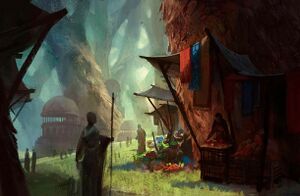
Trade between Meletis and Akros is constant and productive.[7] Caravans make the two-day journey between the poleis at least once a week, carrying fine Akroan metalwork and pottery to Meletis, and Meletian fabric, stonework, and fish northward. Both poleis mint coins of copper, silver, and gold, with the equivalent value. Setessa trades with the other poleis as well, but less extensively. Abora Market, just inside the city gates, is open to outsiders only on certain days, and Setessan merchants prefer to barter goods rather than accept the currency. Despite these restrictions, Setessan food, woodwork, and trained falcons are highly valued in the other poleis.
Aside from the other human poleis, Meletis and Setessa both trade with the centaurs of the Lagonna band.[7] The centaurs don't work metal, so they trade woodwork, the produce of the plains, and woven blankets to the human poleis in exchange for weapons and armor.
Notable Setessans
- Anikthea, a former Setessan member of the Ruling Council.[9] Dragged to the Underworld by Erebos, she serves Setessa's interests as a demigod.
- Anthousa, leader of Leina Tower, as well as commander of Setessa's Ruling Council.
- Renata, legendary hunter later chosen by Nylea as her demigod and champion.
- Kallias, leader of Ophis Tower and one of the five members of Setessa's Ruling Council.
- Nikaia, a Setessan archer who became the first caryatid.[7]
- Niketa, leader of Bassara Tower and one of the five members of Setessa's Ruling Council.
- Phaedra, leader of Hyrax Tower and one of the five members of Setessa's Ruling Council.
- Silverbrow, the fifth member of Setessa's Ruling Council.
- Xenagos, the satyr Planeswalker and later God of revels, was originally born in Setessa.[10]
Trivia
- Setessans referring to their children as "arkulli" may be a direct reference to the cult of Artemis in Brauron, where prepubescent girls called the "arkteia" would dress in short saffron-yellow chitons and imitate bears
- Hoplites of the Leina Tower favoring double-edged axes may be a reference to the labrys, a symbol of the Amazons and later the lesbian community.
- The Nessian Wood may be named after the Hittite polis of Nesa in Anatolia (modern day Turkey, the location of the historical Themyscira).
In-game references
- Associated cards:
- Referred to:
- Anthem of Champions
- Bassara Tower Archer
- Careless Celebrant
- Charging Badger
- Cyclops of Eternal Fury
- Forlorn Pseudamma
- Hunter's Prowess
- Hunt the Hunter
- Hyrax Tower Scout
- Infuriate
- Nessian Boar
- Nexus Wardens
- Nyx Herald
- Oakheart Dryads
- Sanctum Weaver
- Strength of the Harvest
- Vulpine Goliath
- Warriors' Lesson
References
- ↑ Card names of Anthousa, Setessan Hero; Setessan Battle Priest; and Setessan Griffin (Theros).
- ↑ Wizards of the Coast (September 26, 2013). "Theran Pronunciation Quiz". magicthegathering.com. Wizards of the Coast. Archived from the original on 2021-04-30.
- ↑ Mark Rosewater (7 August 2015). "Here is the inspirations for the three main cities (aka poleis).". Blogatog. Tumblr.
- ↑ Theros: Godsend, Part I, Chapter 8
- ↑ Doug Beyer (August 28, 2013). "Are Akros, Setessa and Meletis all associated with specific colours?". A Voice for Vorthos. Tumblr.
- ↑ Mike McArtor (October 1, 2013). "Card of the Day - October, 2013". magicthegathering.com. Wizards of the Coast. Archived from the original on October 18, 2021.
- ↑ a b c d e f g h i j k l m n o p q r s t u v w x y z aa ab ac ad ae Wizards RPG Team (2020), D&D Mythic Odysseys of Theros, Wizards of the Coast
- ↑ a b c The Magic Creative Team (August 28, 2013). "Planeswalker's Guide to Theros, Part 2". magicthegathering.com. Wizards of the Coast.
- ↑ Enduring Enchantments deck insert
- ↑ Clayton Kroh (April 30, 2014). "Thank the Gods". magicthegathering.com. Wizards of the Coast.
